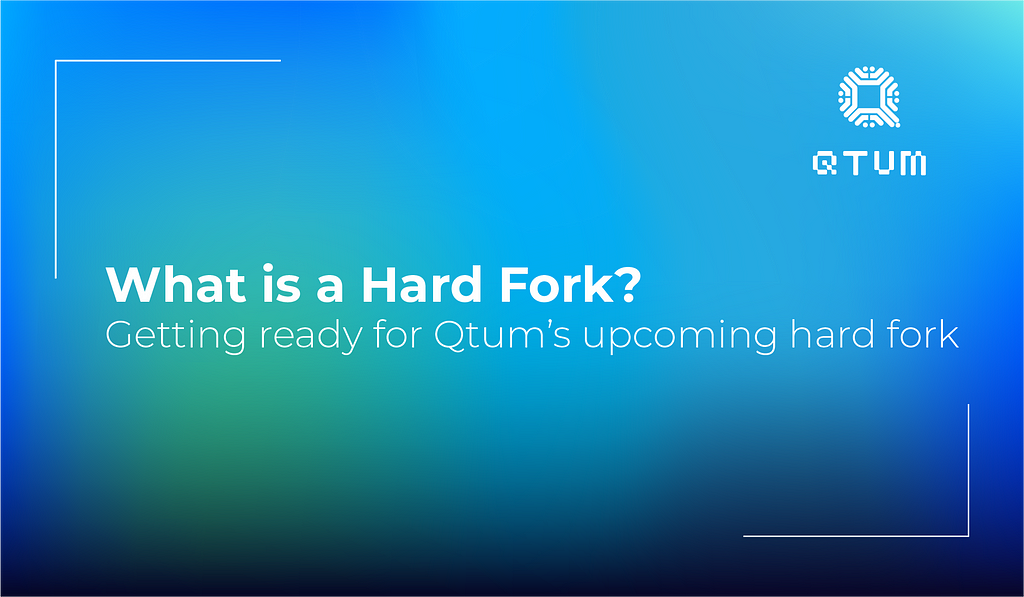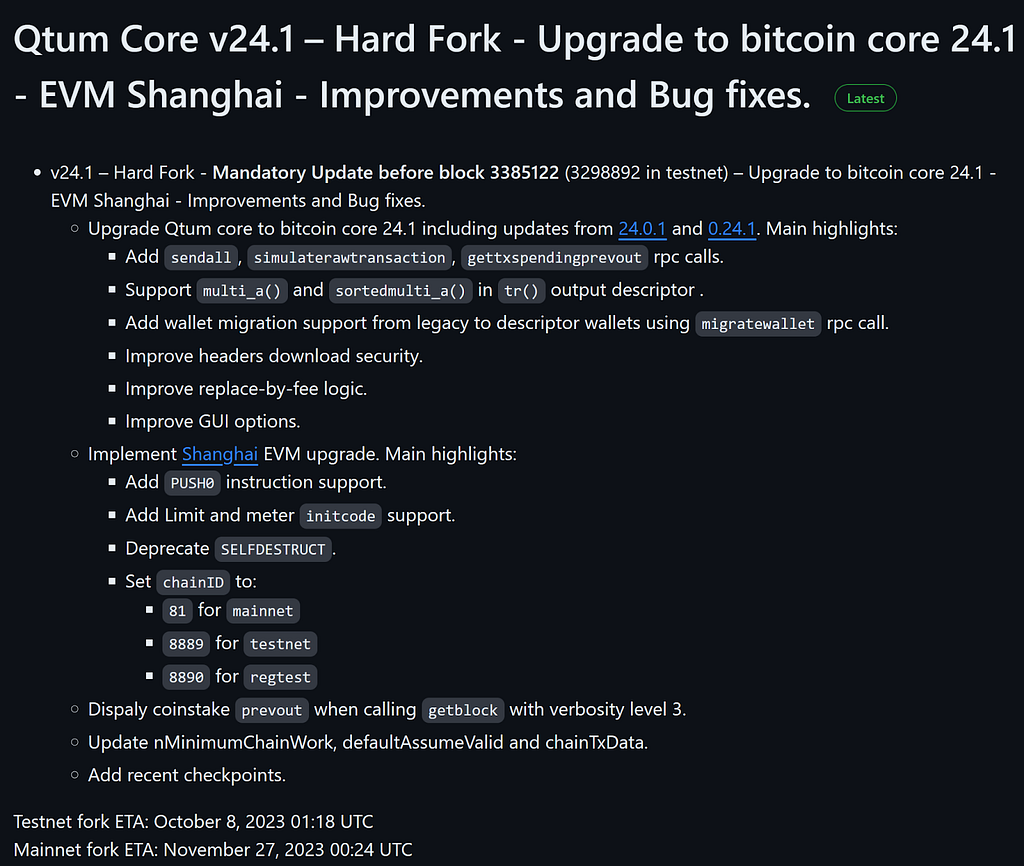


0
1
Getting ready for Qtum’s upcoming hard fork

Blockchain technology is changing how we think about data, security, and decentralized systems in a world where technology is advancing rapidly.
At its core, blockchain is a secure and transparent way to record transactions across multiple computers, ensuring that each entry is immutable and verifiable.
Blockchain is constantly evolving, and one important concept is a “hard fork.”
A hard fork is a significant change or upgrade in the blockchain world that requires all users and nodes who support it to upgrade to the new version to continue participating in the issuer’s vision of a new network.
Users who do not agree with the new vision, or just wish to remain on the old network are free to do so by simply not upgrading to the new version.
The Qtum Foundation developers can’t directly control the network. There are no back doors or hidden switches used to pause the network or blacklist addresses.
We rely on community confidence to support our updates, and users do this by upgrading their nodes.
Once the majority of nodes are upgraded to version 24.1, the hard fork should succeed.
At the time of this article’s writing, over 70% of the nodes (and biggest service providers) are reporting version 24.1, so the hard fork is likely to happen without problems.
A hard fork is a significant change to a network’s protocol. For this change to occur, the majority of nodes or users must upgrade to the latest protocol software version.
A hard fork splits the blockchain into two paths: one that follows the old protocol and another that follows the new one. This can result in two different blockchain versions running in parallel, which has happened in some of the most famous hard fork cases.
When people create a new version of a blockchain, it’s called a hard fork. This can happen for different reasons.
A hard fork can be used to add new features, make the software more secure, undo transactions, blacklist addresses, roll back the chain, change variables that affect speed or transaction costs, etc.
Sometimes, the blockchain community disagrees on how it should work. This can be about how fast and expensive transactions are or more significant differences in what the blockchain should be used for.
There have been several notable hard forks in the blockchain space, each with unique circumstances and outcomes.
For instance, after the DAO attack in 2016, Ethereum underwent a hard fork, which resulted in two separate chains: Ethereum (ETH) and Ethereum Classic (ETC).
In 2017, Bitcoin Cash split from Bitcoin due to disagreements over block size, which affects transaction speed and scalability.
Forks are not just technical events; they are significant moments that enable important enhancements and adaptations to the blockchain network.
Hard forks can introduce new features that make the network more efficient and improve transaction speeds.
Hard forks are also crucial for addressing security concerns. Suppose vulnerabilities are discovered in older versions of the blockchain. In that case, hard forks provide a way to quickly implement fixes and improvements. This helps maintain the integrity and trustworthiness of the network.
Additionally, hard forks can effectively address scalability issues. By enabling fundamental changes to increase the system’s capacity, such as adjusting block size or modifying consensus mechanisms, the network can continue to grow and evolve.
When making changes to a blockchain network through a hard fork, getting agreement from the community of users and stakeholders is essential.
This is because blockchain is decentralized and not controlled by one person or group. Community members operating nodes or stakers must agree to changes and update their nodes or stakers to keep the network functioning properly.
Developers lead the process of proposing changes and working with the community to ensure they understand the changes’ implications.
Miners/stakers also have a say in the outcome of a hard fork because they validate and add transactions to the blockchain.
Their decision to update their nodes and adopt the new protocol is vital for the success of the hard fork.
The Qtum network cannot be controlled by individuals who hold many tokens. The democratic process is determined by nodes and the version of the software they’re running.
While anyone can host multiple nodes, not everyone can have millions of dollars worth of tokens.
Qtum Core version 24.1 is available now on Github:
Releases · qtumproject/qtum (github.com)

Qtum has scheduled a hard fork for their mainnet on November 27, 2023, at 00:24 UTC.
To prepare for this event, the Qtum team has already completed a testnet hard fork on October 8, 2023, at 01:18 UTC.
The successful testnet hard fork was a test run for the upcoming mainnet update.
All network participants must prepare adequately to ensure that they support the Qtum hard fork.
Critical to this preparation is the update to Qtum build v24.1, which must be implemented across the main network by a majority of nodes before reaching block height 3385122, which is estimated to happen around November 27th, 2023.
If you supported the previous Qtum updates developed by the Qtum Foundation and agree with this latest update, please make sure your node is updated so that Qtum Core version 24.1 has the most community confidence.
Qtum has provided comprehensive information and instructions on its GitHub page to aid in this process. This resource includes detailed release notes and guidance, ensuring that all community members, developers, and miners have the necessary knowledge and tools to update their systems seamlessly.
The Qtum team strongly encourages all participants to review these materials well before the hard fork to ensure a smooth transition.
The upcoming hard fork is more than just a technical update; it’s a step towards a more advanced and efficient Qtum blockchain.
By staying informed and preparing adequately, the Qtum community can look forward to embracing the new possibilities that this update will bring.
Your involvement is not just limited to updating the software. It extends to staying informed, engaging in community discussions, and understanding the changes that come with the hard fork.
The collective effort of each member plays a critical role in the seamless implementation of this significant network upgrade.
Hard forks are important for blockchain technology to evolve and advance. This is the case for Qtum’s upcoming hard fork. It represents a moment of significant change, reflecting the dynamic nature of this field.
Looking beyond this hard fork, we anticipate blockchain technology to continue innovating and adapting, offering new solutions across various sectors.
For more detailed information, release notes, and instructions regarding the Qtum hard fork, please refer to the following resources:
0
1
 Կառավարեք ձեր բոլոր կրիպտարժույթները, NFT-ն և DeFi-ն՝ մեկ տեղից
Կառավարեք ձեր բոլոր կրիպտարժույթները, NFT-ն և DeFi-ն՝ մեկ տեղիցԱպահովաբար կցեք ձեր օգտագործած պորտֆոլիոն՝ սկսելու համար: